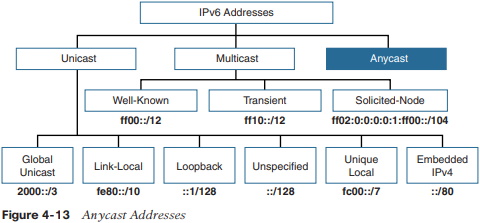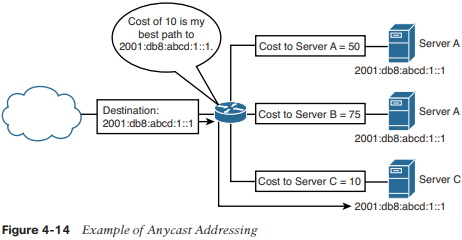An IPv6 anycast address is an address that can be assigned to more than one interface (typically different devices). In other words, multiple devices can have the same anycast address. A packet sent to an anycast address is routed to the "nearest" interface having that address, according to the router's routing table.

Anycast addresses are available for both IPv4 and IPv6, initially defined in RFC 1546, Host Anycasting Service. Anycast was meant to be used for services such as DNS and HTTP but was never really implemented as designed.
There is no special prefix for an IPv6 anycast address. An IPv6 anycast address uses the same address range as global unicast addresses. Each participating device is configured to have the same anycast address. For example, servers A, B, and C in Figure 4-14 could be DHCPv6 servers with a direct Layer 3 connection into the network. These servers could advertise the same /128 address using OSPFv3. The router nearest the client request would then forward packets to the nearest server identified in the routing table.

There are some reserved anycast address formats such as the subnet-router anycast address defined in RFC 4291 and RFC 2526. IPv6 anycast addressing is still somewhat in the experimental stages.
About the Author
Rick Graziani has been an instructor of computer networking and computer science courses at Cabrillo College in Aptos, California since 1994. Rick also teaches networking courses in the Computer Engineering department at the University of California, Santa Cruz and is on the Curriculum Engineering team for Cisco Networking Academy.
Organizations are increasingly transitioning to IPv6, the next generation protocol for defining how devices of all kinds communicate over networks. Now fully updated, IPv6 Fundamentals offers a thorough, friendly, and easy-to-understand introduction to the knowledge and skills you need to deploy and operate IPv6 networks.
Leading networking instructor Rick Graziani explains all the basics simply and clearly, step-by-step, providing all the details you'll need to succeed. You'll learn why IPv6 is necessary, how it was created, how it works, and how it has become the protocol of choice in environments ranging from cloud to mobile and IoT.
Graziani thoroughly introduces IPv6 addressing, configuration options, and routing protocols, including EIGRP for IPv6, and OSPFv3 (traditional configuration and with address families). Building on this coverage, he then includes more in-depth information involving these protocols and processes.
This edition contains a completely revamped discussion of deploying IPv6 in your network, including IPv6/IPv4 integration, dynamic address allocation, and understanding IPv6 from the perspective of the network and host. You'll also find improved coverage of key topics such as Stateless Address Autoconfiguration (SLAAC), DHCPv6, and the advantages of the solicited node multicast address.
Throughout, Graziani presents command syntax for Cisco IOS, Windows, Linux, and Mac OS, as well as many examples, diagrams, configuration tips, and updated links to white papers and official RFCs for even deeper understanding.
• Learn how IPv6 supports modern networks encompassing the cloud, mobile, IoT, and gaming devices
• Compare IPv6 with IPv4 to see what has changed and what hasn't
• Understand and represent IPv6 addresses for unicast, multicast, and anycast environments
• Master all facets of dynamic IPv6 address allocation with SLAAC, stateless DHCPv6, and stateful DHCPv6
• Understand all the features of deploying IPv6 addresses in the network including temporary addresses and the privacy extension
• Improve operations by leveraging major enhancements built into ICMPv6 and ICMPv6 Neighbor Discovery Protocol
• Configure IPv6 addressing and Access Control Lists using a common topology
• Implement routing of IPv6 packets via static routing, EIGRP for IPv6, and OSPFv3
• Walk step-by-step through deploying IPv6 in existing networks, and coexisting with or transitioning from IPv4
Reader Lucas Schultz says, "If you are looking to take the CCNA and IPv6 is not clear to you after Cisco material, this is the book you. This is the best in depth discuss about IPv6 how it works and the mechanisms to make it work. Author made it very easy to read and understand. Highly recommend this book to IT personnel or CCNA certification.
More Networking Protocols and Standards:
• Internet Security and VPN Network Design
• Wireless Standards - 802.11a 802.11b 802.11g 802.11n 802.11i Explained
• IPv6 Multicast Addresses
• What is PPP, PPPoA and PPPoE?
• OSPF (Open Shortest Path First) Protocol
• Classless IP Addressing
• Integration of IPv6 with IPv4
• Major Protocols in the TCP/IP Suite
• The TCP/IP protocol Datagram Format
• Understanding IP Routing



